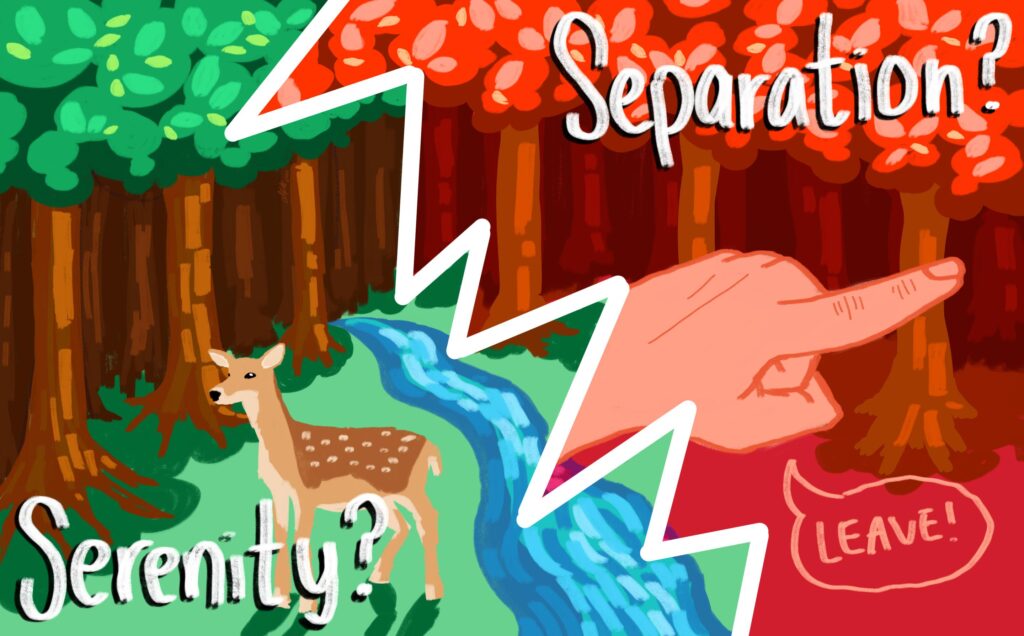
The picturesque blue clouds come to life in the painting as they contrast the stark cliffs full of youthful bighorn sheep. Worldwide, national parks are painted as serene and highly beneficial to conservation efforts that help protect our deteriorating world. Most people visualize iconic landscapes with herds of animals roaming care-free. This view has been intentionally curated since the beginning of colonial times when English painters began emphasizing this kind of human-free beauty (Neumann 20). In this article, the examination of national parks will go beyond the pretty paintings of its surface to explore how the creation and maintenance of these “oases” may have a darker past than most may have thought.
Conservation is often framed as an effort towards providing spaces for nature to thrive with support from human intervention, but with distinct separation from consistent human stewardship. This may seem reasonable at first because the majority of the population is used to hearing this conservation narrative, but what about the establishment of these places in the first place? There are hardly ever spaces as vast as most national parks that were ever truly empty or uninhabited, so where did those people go? For example, Yellowstone National Park wouldn’t have been possible without the defeat of Miwok warriors “by the United States military [that] cleared the way for the establishment of Yosemite Valley as a tourist attraction” (Neumann 30). “Clearing the way” is referring to excluding these nomadic peoples from their hunting grounds and place of husbandry where they had been present for thousands of years prior (Hecht 274). Unfortunately, oppression of indigenous peoples once again surfaces as a key player in the development of these colonial systems. It is also important to note that this kind of necessity of separation between peoples and nature is one of colonialisms’ finest flaws. Clearly, if indigenous peoples had been living throughout these spaces for thousands of years, their collaboration with the land must’ve been one of beneficial reciprocity. Many indigenous peoples refer to their roots with the land as a position of stewardship amidst a “culture of gratitude” (Kimmerer) instead of conservationists, so the colonial dictation that national parks would now be restricted spaces goes against all they did to take care of our natural world.
This kind of forced dislocation in the name of conservation has not by any means isolated to the United States, as can be seen by the conflict between the Maasai and the Tanzanian government. The Maasai are indigenous peoples who have called the Serengeti home for a long, long time, but that didn’t stop the government from expanding conservation reserves into their homelands. In 2022, the government attempted to bribe the Maasai into free housing four hundred miles south and met the villages with extreme force including physical barriers, destruction of property, and opening fire on the peoples when they refused (McCrummen). Tanzania is also home of the conflict with the Meru people who call the slopes of Mount Meru home and are constantly oppressed by the regulations of Arusha National Park (Nuemann 12). All of this said, it is important to see these peoples as resistors rather than just victims because they all engage in resistance. One example of this resistance for the Meru, was that even amidst some of the strictest game and lumber prohibitions, they continued to push for rights to beekeeping, an age-old practice on Mount Meru. They fought for these rights and won them for a while until the government blamed a series of wildfires on the “honey-hunters” and again increased restrictions on their access to resources and practice (Neumann 114). This didn’t cease their resistance though, they continued to protest these regulations, most commonly in the form of illegal grazing. Their cases would be brought to Meru courts where the Meru judges were often able to dismiss these cases without discipline, and this continued into the 1960s (Neumann 119).
These intersections between conservation and dislocation are not talked about enough. Cultivating safe spaces for nature and people should be a priority of conservation, or even better stewardship efforts. Those leading or participating in these fields should remember humans are a part of nature at our roots and therefore symbiotic relationships are needed to move forward. Separating people and land is just another division our world has no use for. We can’t care for one without considering its effects on the other. Whether it is national parks or local trusts, I just ask that those involved consider how we got to where we are and whether the steps we’re taking are uniting us and the health of our world or separating it.
Works Cited
Hecht, Susanna B., and Alexander Cockburn. The Fate of the Forest: Developers, Destroyers and Defenders of the Amazon. HarperCollins, 1990.
Kimmerer, Robin. “Restoration and reciprocity: The contributions of traditional ecological knowledge.” Human Dimensions of Ecological Restoration, 2011, pp. 257–276, https://doi.org/10.5822/978-1-61091-039-2_18.
McCrummen, Stephanie. “‘This Will Finish Us.’” The Atlantic, Atlantic Media Company, 9 May 2024, www.theatlantic.com/magazine/archive/2024/05/maasai-tribe-tanzania-forced-land-evictions-serengeti/677835/.
Neumann, Roderick P. Imposing Wilderness: Struggles over Livelihood and Nature Preservation in Africa. University of California Press, 2002.
The views and opinions expressed are those of the authors and do not necessarily reflect nor represent the Earth Chronicles and its editorial board.




